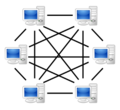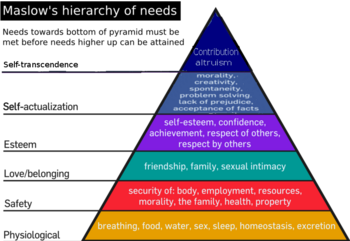Open collaborative design/What is the motivation to contribute?
20th century economics was driven by an assumption that people act exclusively out of self-interest. If you want to make people perform better, so the wisdom goes, you reward them with money and privileges, and if you want them to stop doing something, you threaten them with punishment. This is the almost unquestioned common-sense of the entire economic and corporate landscape, yet it is not well proven. In fact, there is abundant evidence from social and psychological research that this sort of extrinsic motivation  actually reduces performance and interest in creative tasks[1][2][3][4]. The belief that people can only be motivated by reward and punishment is based on an unrealistically pessimistic view of human nature. The fact of the matter is that humans are capable of creativity, curiosity, community and contribution.
actually reduces performance and interest in creative tasks[1][2][3][4]. The belief that people can only be motivated by reward and punishment is based on an unrealistically pessimistic view of human nature. The fact of the matter is that humans are capable of creativity, curiosity, community and contribution.
These are some reasons why someone might want to contribute to the 'universal commons' of free and open designs:
- The fun and challenge of working on an interesting project. Simple creative satisfaction (something rather lacking in this age of 'consumer culture'). It is very gratifying to work on a project that you are good at and thereby create something worthwhile (i.e. self-esteem in Maslow's theory of motivation illustrated below)
- People give positive feedback and praise, and the creator(s) enjoy respect for their efforts. (i.e. the esteem of others in Maslow's theory of motivation)
- The sense of community created by working together with like-minded people around the globe (i.e. belongingness in Maslow's theory)
- Building upon existing components and assemblies from the universal commons allows people to create things of a complexity and scale that they would not be able to achieve alone. By calling upon the rest of humanity to collaborate with you, you can achieve things in a fraction of the time.
- Products and machines can be individually customised to a high degree. Compared to traditional top-down economics, open collaboration makes a much less sharp distinction between consumers and producers; every consumer has the opportunity to participate in the design of the products they use, allowing them to get it just the way they like it. This can be seen, for example, in the FireFox web browser, which is much more customizable than any closed-source web browser.
- Other people may evolve your design further, which could benefit you as they might improve it or make additions you hadn't thought of.
- The concept of copyleft
 and Creative Commons changes the way people think about contributing their effort and time to creative open projects, as the contributions are for the benefit of everyone and anyone. The sense of community around open-source projects brings out Man's altruism; we give willingly to others whom we consider to be part of the same tribe as ourselves. As anyone who's ever been to Burning Man knows, once you are immersed in a gift economy for a little while, giving comes as easily as taking. A widely used design gives satisfaction to the creator knowing that many other people are getting practical use or joy from it, fulfilling another of the needs in Maslow's theory of motivation: that of self-transcendence, contributing beyond oneself.
and Creative Commons changes the way people think about contributing their effort and time to creative open projects, as the contributions are for the benefit of everyone and anyone. The sense of community around open-source projects brings out Man's altruism; we give willingly to others whom we consider to be part of the same tribe as ourselves. As anyone who's ever been to Burning Man knows, once you are immersed in a gift economy for a little while, giving comes as easily as taking. A widely used design gives satisfaction to the creator knowing that many other people are getting practical use or joy from it, fulfilling another of the needs in Maslow's theory of motivation: that of self-transcendence, contributing beyond oneself.
- Reciprocity has long been identified (by Robert Cialdini
 and others) as one of the key ways to motivate anyone to do anything. People who benefit from open-source projects feel motivated to give back to the community.
and others) as one of the key ways to motivate anyone to do anything. People who benefit from open-source projects feel motivated to give back to the community.
- Social momentum - when a large enough group of people collaborate on a project, it creates a bandwagon effect. We are easily motivated to do something when we see that a lot of other people are doing it.
- Working on an open-project that may become a component of a wider technological ecosystem which moves modern society closer to being a truly advanced civilisation — rather than the compromised and highly unoptimised reality of the world today: one that is destroying the environment, not providing for the needs of the global population and with a significant percentage of people shackled to jobs and lifestyles they do not enjoy.
- Ultimately the reasons that already motivate many hundreds of thousands of people to contribute to open-source software and similar collaborative endeavours world-wide will spread to other endeavours. The bottom line is, regardless of why people contribute to open projects, the fact of the matter is that they do contribute: over 100,000,000 hours of time and effort have gone into building Wikipedia, over 45,000 Kenyans contributed to Ushahidi
A relevant quote from Benjamin Franklin  that becomes more plausible in the age of the internet and Open Source:
that becomes more plausible in the age of the internet and Open Source:
“... as we enjoy great advantages from the inventions of others, we should be glad of an opportunity to serve others by any invention of ours; and this we should do freely and generously.”
That people would do work without being paid may be mystifying in an economic context of scarcity, but in a condition of abundance people become more willing to contribute to others. Open collaborative design goes hand-in-hand with abundance. This is shown in Maslow's pyramid below.
Abraham Maslow's well-respected theory of motivation  - contributing to open collaborative projects fulfils the human needs to belong, to be esteemed, to know and understand, to actualize one's potentials and abilities, and to transcend oneself by contributing to something greater.
- contributing to open collaborative projects fulfils the human needs to belong, to be esteemed, to know and understand, to actualize one's potentials and abilities, and to transcend oneself by contributing to something greater.
It is interesting to note that scarcity-based economies focus on man's two lowest needs: security and physiological needs, while in a situation of Post-scarcity the lower needs are a non-issue, so the higher needs come into sharper focus.
It has been shown again and again and again in psychological studies that extrinsic carrot-and-stick motivation is effective only at tasks that require no insight or creativity i.e. mechanistic tasks. But our society is moving towards automating more and more of these tasks, so that the jobs left for people to do are the ones that require dealing with ambiguities, thinking laterally and finding creative, non-obvious solutions. For these tasks, only intrinsic motivation is effective, with extrinsic rewards and punishments usually leading to lower performance. This may be surprising (it certainly flies in the face of traditional notions of incentives) but it has been proven again and again [5][6][7].

